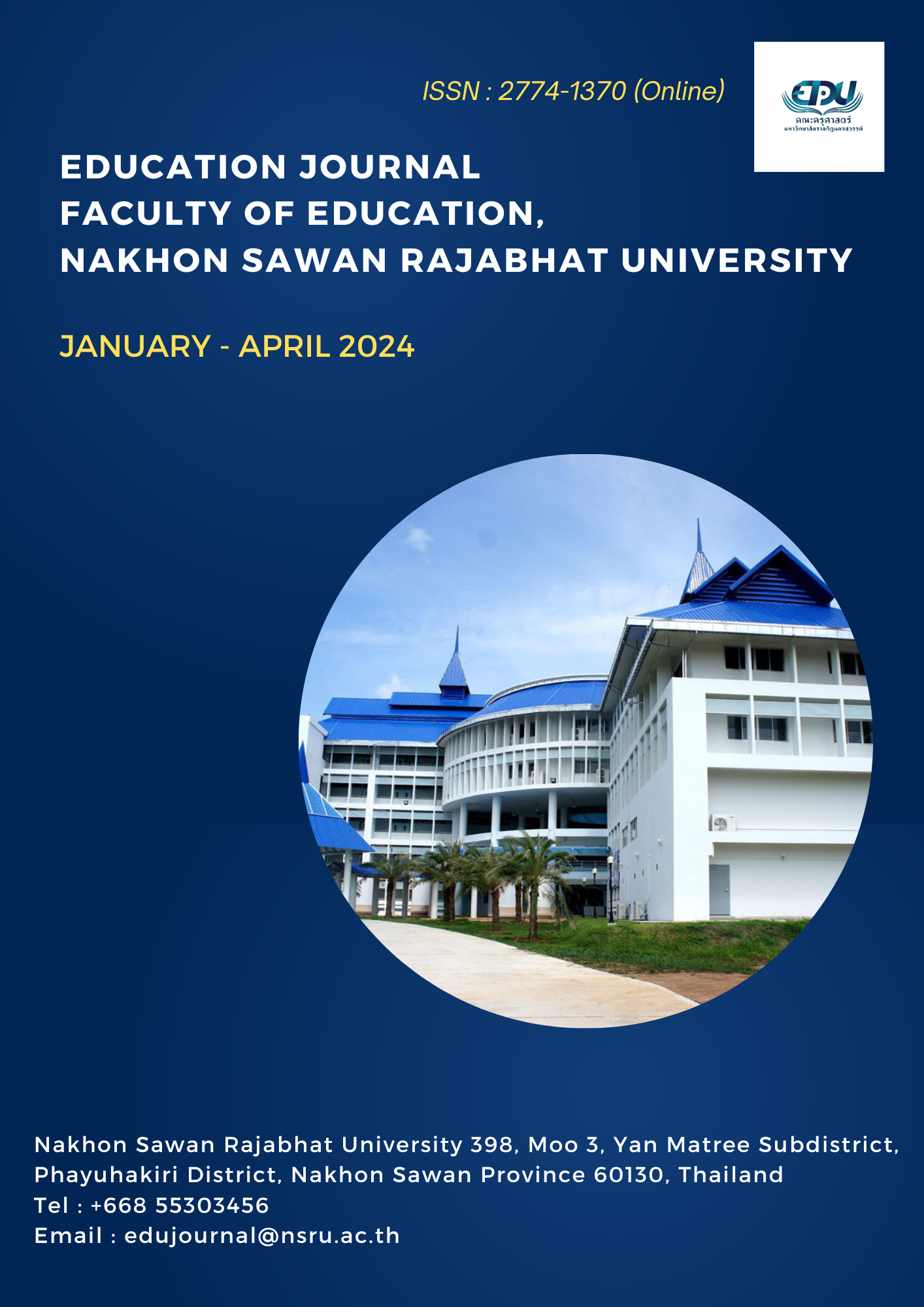Effects of Learning Management Using Problem Base Learning with Micro:bit on Problem Solving Ability in Computer Science Subject of Matthayom 1 Students
Main Article Content
Abstract
The purposes of this research were 1) to study the problem-solving abilities of students in Matthayom 1 who received learning management using problem base learning with Micro: bit and 2) to compare the problem-solving abilities of students in Matthayom 1 who received learning management using problem base learning with Micro: bit with criteria 70 percent of the full score. The research samples were 17 students from one classroom in Matthayom 1, the first-semester academic year 2022 from Ban Bueng Rat School under Nakhonsawan Primary Education Service Area Office 2. The research samples were selected using group randomization with the school as the random sampling unit. The research instruments were 1) 4 lesson plans of 12-hour problem-solving abilities on the micro: bit board with high average suitability ( = 4.56, S.D. = 0.48), and 2) problem-solving abilities assessment test on Computer Science subject using 4 levels rubric scoring criteria. The validity using the Index of Item – Objective Congruence (IOC) equals 0.67 – 1.00, and the reliability using the Rater Agreement Index (RAI) equals 0.88. Data analyzed using mean, standard deviation, and Wilcoxon Signed Rank Test. The research findings were as follows:
1) The students in Matthayom 1, after participating in learning management using problem base learning with Micro: bit, most of the students had the problem-solving ability at the highest level of 70.58 percent and the rest were at the good level of 29.42 percent 2) The students in Matthayom 1, who participated in learning management using problem base learning with Micro: bit, had an average problem-solving ability of 34.71, a standard deviation at 1.96 which was higher than the criteria 70 percent of the full score and were statistically significant at the .05 level.
Downloads
Article Details

This work is licensed under a Creative Commons Attribution-NonCommercial-NoDerivatives 4.0 International License.
References
ชัยวัฒน์ สุทธิรัตน์. (2553). 80 นวัตกรรมการจัดการเรียนรู้ที่เน้นผู้เรียนเป็นสำคัญ. กรุงเทพฯ: แดเน็กซ์ อินเตอร์คอร์ปอเรชั่น.
ตะวัน เทวอักษร. (2561). การศึกษาไทยยุค 4.0 “ห้องเรียนที่ดีต้องปฏิสัมพันธ์กัน”. สืบค้นเมื่อ 15 ธันวาคม 2565, จากhttps://www.prachachat.net/education/news-245331.
ทิศนา แขมมณี. (2552). ศาสตร์การสอน. (พิมพ์ครั้งที่ 5). กรุงเทพฯ: ด่านสุทธาการพิมพ์.
มลฤดี เพ็งสง่า. (2559). การเรียนแบบผสมผสานโดยใช้ปัญหาเป็นหลัก เพื่อส่งเสริมความสามารถในการแก้ปัญหาการเขียนโปรแกรมควบคุมหุ่นยนต์ สำหรับนักเรียนชั้นประถมศึกษา. วิทยานิพนธ์ศึกษาศาสตรมหาบัณฑิต (เทคโนโลยีการศึกษา). มหาวิทยาลัยศิลปากร.
วัชรา เล่าเรียนดี. (2555). การศึกษาปัญหาการนิเทศภายในสถานศึกษาตามความคิดเห็นของผู้บริหาร. นครปฐม: โรงพิมพ์มหาวิทยาลัยศิลปากร วิทยาเขตพระราชวังสนามจันทร์.
สถาบันส่งเสริมการสอนวิทยาศาสตร์และเทคโนโลยี. (2560). คู่มือการใช้หลักสูตรสาระเทคโนโลยี (วิทยาการคำนวณ) รายวิชาวิทยาศาสตร์ ฉบับปรับปรุง พ.ศ.2560. กรุงเทพฯ: ผู้แต่ง.
สำนักงานเลขาธิการสภาการศึกษา. (2550). แนวทางการจัดการเรียนรู้ที่เน้นผู้เรียนเป็นสำคัญการจัดการเรียนรู้แบบใช้ปัญหาเป็นฐาน. กรุงเทพฯ: ชุมนุมสหกรณ์การเกษตรแห่งประเทศไทย.
สุพจน์ ดอกจันทร์กลาง. (2556). ผลการเรียนด้วยบทเรียนบนเว็บแบบผสมผสานโดยใช้ปัญหาเป็นฐานกับการเรียนแบบใช้ปัญหาเป็นฐาน เรื่อง เทคโนโลยีสารสนเทศและการสื่อสาร ชั้นมัธยมศึกษาปีที่ 2. วิทยานิพนธ์การศึกษามหาบัณฑิต (เทคโนโลยีและสื่อสารการศึกษา). มหาวิทยาลัยราชภัฏมหาสารคาม.
สุรางคณา เหลืองกิจไพบูลย์. (2563). การพัฒนาการจัดการเรียนรู้แบบใช้ปัญหาเป็นฐานด้วยบอร์ดอิเล็กทรอนิกส์ Micro:bit เพื่อส่งเสริมการคิดแก้ปัญหาด้วยแนวคิดเชิงคำนวณวิชาเทคโนโลยี (วิทยาการคำนวณ). วิทยานิพนธ์ศึกษาศาสตรมหาบัณฑิต (การศึกษาวิทยาศาสตร์และเทคโนโลยี). มหาวิทยาลัยขอนแก่น.


